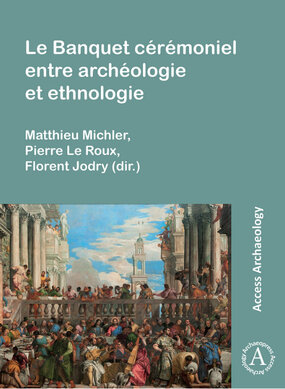Matthieu Michler, Pierre Le Roux, Florent Jodry (dir.)
Actes des journées d’étude internationales et interdisciplinaires, MISHA, université de Strasbourg, 6-7 mai 2021,
2024, Oxford, Archaeopress, 406 p.
DOI : 10.32028/9781803277554
Résumé : Une double approche, associant les points de vue de l’anthropologie sociale et de l’archéologie, permet de révéler le banquet ou festin cérémoniel comme phénomène social total. En effet, en des occurrences extraordinaires, il rassemble, le plus souvent dans des sociétés stratifiées à religion sacrificielle, de nombreux convives abreuvés et nourris de mets rares et onéreux en grandes quantités afin d’honorer quelqu’un ou quelque chose et pour affirmer avec ostentation la puissance des organisateurs. Si cette pratique a été reconnue dans de nombreuses sociétés du monde entier, vivantes, anciennes ou disparues, elle n’avait pas encore fait l’objet d’une synthèse d’envergure. Il convenait donc de s’interroger de façon interdisciplinaire sur les tenants et aboutissants du banquet festif en rapport aux cosmogonies et pratiques sociales des espaces sociaux concernés. Les neuf essais rassemblés ici, issus des communications données aux journées d’étude tenues à Strasbourg, contribuent à alimenter le débat concernant des questions d’importance relatives au banquet comme sa temporalité (cycles des cultures ou mythes cosmogoniques), sa localisation (sphère publique ou privée, plein-air ou intérieur), la commensalité, l’hospitalité, le genre de produits consommés et les manières de table, posant enfin l’hypothèse que l’organisation d’un banquet implique l’existence d’une société hiérarchisée, sédentaire, à richesse (ou chrématique), sinon ostentatoire. La diversité des aires géoculturelles, des périodes chronologiques et des cas traités permet d’appréhender le banquet sous ses multiples aspects en proposant de nouvelles réflexions et pistes de recherche.
Abstract: Combining the points of view of social anthropology and archaeology has made it possible to reveal the banquet or ceremonial feast as a total social phenomenon. Indeed, occurring only in rare occasions, it gathers, most often in stratified societies with sacrificial religions, large numbers of guests treated to drinks and rare and expensive foods in quantity, to honour someone or something and to ostentatiously display the organisers’ power. While this practice has been recognised in many societies, living, ancient or extinct, around the world, it had not yet been made the subject of a large-scale synthesis. It was therefore necessary to question in an interdisciplinary way the ins and outs of the festive banquet in relation to the cosmogonies and social practices of the social spaces concerned. The nine essays collected here, derived from the communications given at the workshop held in Strasbourg, contribute to the debate on important questions linked to the banquet, such as temporality (farming cycles or cosmogonic myths), location (public or private, outdoors or indoors), commensality, hospitality, types of products consumed, and table manners, finally posing the hypothesis that the organisation of a banquet implies the existence of a wealthy sedentary hierarchical society, if not ostentatious. The diversity of geo-cultural areas, time periods, and cases treated made it possible to capture the banquet in its many aspects by suggesting new ideas and paths of research.
SOMMAIRE/SUMMARY
• Ouverture des journées d’étude « lLe banquet cérémoniel »/Opening of the Workshop “The Ceremonial banquet”
Philippe HAMMAN, p. 1-2
• À table !/Dinner’s ready!
Matthieu MICHLER, p. 3-4
• Introduction : le banquet cérémoniel entre archéologie et ethnologie/Introduction: the ceremonial banquet between archaeology and ethnology
Pierre LE ROUX , Matthieu MICHLER, Luc JALLOT, Florent JODRY, p. 5-20
• Nous allons manger du riz gluant. Banquets cérémoniels chez les Jawi de Thaïlande du Sud et les anciens Malais péninsulaires et quelques autres lieux/We will eat glutinous rice. Ceremonial banquets amongst the Jawi of Southern Thailand and the ancient Peninsular Malays, and some other places
Pierre LE ROUX, p. 21-129
• Bières et boissons fermentées en Europe pré- et protohistorique. Approches pluridisciplinaires pour une meilleure compréhension des pratiques de commensalité/Beers and fermented beverages in Pre- and Protohistoric Europe. Multidisciplinary approaches toward a better understanding of commensality practices
Matthieu MICHLER, p. 131-161
• Le « Message des meules » : céréales, moutures et pains s’invitent aux banquets. Approches transversales des pratiques alimentaires liées aux outils de mouture/The “Message from the millstones”: cereals, grinds and breads are invited to feasts. Ccross-cutting approaches to food practices related to grinding tools
Florent JODRY, p. 163-184
• Vivre la paix et l’abondance. Épilogue au banquet fidjien/Living peace and plenty. Epilogue to Fijian banquet
Marc ROCHETTE, p. 185-200
• Caractérisation biomoléculaire des pratiques alimentaires et festives dans les grands centres de pouvoir hallstattiens/Biomolecular characterisation of food and festive practices in two major hallstattian power centres
Maxime RAGEOT, p. 201-207
• Structures archéologiques à pierres chauffées : un petit air de Polynésie ? Assurément, mais pas exclusivement ! Tour d’horizon des fours de terre documentés par l’ethnologie et apports pour l’archéologie/Archaeological hot stones structures: a touch of polynesia? Certainly, but not exclusively! An overview of earth ovens documented by ethnology and their contribution to archaeology
Pauline HART, p. 209-245
• Nourrir et manger. Repas cérémoniels de sociétés initiatiques (province du Moyen-Ogooué, Gabon)/Both feeding and eating. Ceremonial meals in initiation societies (Middle Ogooué province, Gabon)
Eurydice DEVOS & Marc-Emmanuel GRANDGEORGE, p. 247-268
• Le banquet cérémoniel néolithique est-il fait de cuissons collectives, de bâtiments communautaires, de festins cannibales ?/Is the Neolithic ceremonial banquet made up of collective cooking, community buildings, cannibal feasts?
Luc JALLOT, p. 269-354
• Joindre les vivants, éconduire les morts. Le banquet cérémoniel chez les Gitans d’Espagne/Joining the living, driving the dead away. The ceremonial banquet amongst the Gypsies of Spain
Nathalie MANRIQUE, p. 355-369
• Si tu manges du bouillon d’Awara en Guyane tu reviendras. Introduction à la projection du film Le Bouillon d’Awara/If you eat Awara broth in Guiana you will come back. Introduction to the screening of the film Le Bouillon d’Awara
Florent JODRY, p. 371-374
• Biographie des contributeurs/Biography of the contributors, p. 375-382






